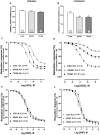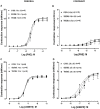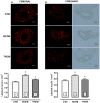Interaction between advanced glycation end products formation and vascular responses in femoral and coronary arteries from exercised diabetic rats
- PMID: 23285277
- PMCID: PMC3532341
- DOI: 10.1371/journal.pone.0053318
Interaction between advanced glycation end products formation and vascular responses in femoral and coronary arteries from exercised diabetic rats
Abstract
Background: The majority of studies have investigated the effect of exercise training (TR) on vascular responses in diabetic animals (DB), but none evaluated nitric oxide (NO) and advanced glycation end products (AGEs) formation associated with oxidant and antioxidant activities in femoral and coronary arteries from trained diabetic rats. Our hypothesis was that 8-week TR would alter AGEs levels in type 1 diabetic rats ameliorating vascular responsiveness.
Methodology/principal findings: Male Wistar rats were divided into control sedentary (C/SD), sedentary diabetic (SD/DB), and trained diabetic (TR/DB). DB was induced by streptozotocin (i.p.: 60 mg/kg). TR was performed for 60 min per day, 5 days/week, during 8 weeks. Concentration-response curves to acetylcholine (ACh), sodium nitroprusside (SNP), phenylephrine (PHE) and tromboxane analog (U46619) were obtained. The protein expressions of eNOS, receptor for AGEs (RAGE), Cu/Zn-SOD and Mn-SOD were analyzed. Tissues NO production and reactive oxygen species (ROS) generation were evaluated. Plasma nitrate/nitrite (NO(x)⁻), superoxide dismutase (SOD), catalase (CAT), thiobarbituric acid reactive substances (TBARS) and N(ε)-(carboxymethyl) lysine (CML, AGE biomarker). A rightward shift in the concentration-response curves to ACh was observed in femoral and coronary arteries from SD/DB that was accompanied by an increase in TBARS and CML levels. Decreased in the eNOS expression, tissues NO production and NO(x)⁻ levels were associated with increased ROS generation. A positive interaction between the beneficial effect of TR on the relaxing responses to ACh and the reduction in TBARS and CML levels were observed without changing in antioxidant activities. The eNOS protein expression, tissues NO production and ROS generation were fully re-established in TR/DB, but plasma NO(x)⁻ levels were partially restored.
Conclusion: Shear stress induced by TR fully restores the eNOS/NO pathway in both preparations from non-treated diabetic rats, however, a massive production of AGEs still affecting relaxing responses possibly involving other endothelium-dependent vasodilator agents, mainly in coronary artery.
Conflict of interest statement
Figures







Similar articles
-
Advanced glycation end products accelerate rat vascular calcification through RAGE/oxidative stress.BMC Cardiovasc Disord. 2013 Mar 5;13:13. doi: 10.1186/1471-2261-13-13. BMC Cardiovasc Disord. 2013. PMID: 23497312 Free PMC article.
-
Advanced glycation end-products decreases expression of endothelial nitric oxide synthase through oxidative stress in human coronary artery endothelial cells.Cardiovasc Diabetol. 2017 Apr 20;16(1):52. doi: 10.1186/s12933-017-0531-9. Cardiovasc Diabetol. 2017. PMID: 28427390 Free PMC article.
-
Oxygen-derived free radicals mediate endothelium-dependent contractions in femoral arteries of rats with streptozotocin-induced diabetes.Br J Pharmacol. 2007 Dec;152(7):1033-41. doi: 10.1038/sj.bjp.0707439. Epub 2007 Sep 3. Br J Pharmacol. 2007. PMID: 17767168 Free PMC article.
-
Reduction of advanced-glycation end products levels and inhibition of RAGE signaling decreases rat vascular calcification induced by diabetes.PLoS One. 2014 Jan 21;9(1):e85922. doi: 10.1371/journal.pone.0085922. eCollection 2014. PLoS One. 2014. PMID: 24465790 Free PMC article.
-
Nicorandil prevents endothelial dysfunction due to antioxidative effects via normalisation of NADPH oxidase and nitric oxide synthase in streptozotocin diabetic rats.Cardiovasc Diabetol. 2011 Nov 23;10:105. doi: 10.1186/1475-2840-10-105. Cardiovasc Diabetol. 2011. PMID: 22107602 Free PMC article.
Cited by
-
Treadmill running improves hindlimb arteriolar endothelial function in type 1 diabetic mice as visualized by X-ray microangiography.Cardiovasc Diabetol. 2015 May 13;14:51. doi: 10.1186/s12933-015-0217-0. Cardiovasc Diabetol. 2015. PMID: 25964060 Free PMC article.
-
Methylglyoxal Exacerbates Lipopolysaccharide-Induced Acute Lung Injury via RAGE-Induced ROS Generation: Protective Effects of Metformin.J Inflamm Res. 2021 Dec 2;14:6477-6489. doi: 10.2147/JIR.S337115. eCollection 2021. J Inflamm Res. 2021. PMID: 34880648 Free PMC article.
-
Taurine supplementation reduces blood pressure and prevents endothelial dysfunction and oxidative stress in post-weaning protein-restricted rats.PLoS One. 2014 Aug 29;9(8):e105851. doi: 10.1371/journal.pone.0105851. eCollection 2014. PLoS One. 2014. PMID: 25170895 Free PMC article.
-
Importance of AT1 and AT2 receptors in the nucleus of the solitary tract in cardiovascular responses induced by a high-fat diet.Hypertens Res. 2019 Apr;42(4):439-449. doi: 10.1038/s41440-018-0196-0. Epub 2019 Jan 10. Hypertens Res. 2019. PMID: 30631157 Free PMC article.
-
Metabolic parameters and responsiveness of isolated iliac artery in LDLr-/- mice: role of aerobic exercise training.Am J Cardiovasc Dis. 2017 Apr 15;7(2):64-71. eCollection 2017. Am J Cardiovasc Dis. 2017. PMID: 28533932 Free PMC article.
References
-
- Zanesco A, Antunes E (2007) Effects of exercise training on the cardiovascular system: pharmacological approaches. Pharmacol Ther 114: 307–317. - PubMed
-
- Sponton CH, Rezende TM, Mallagrino PA, Franco-Penteado CF, Bezerra MA, et al. (2010) Women with TT genotype for eNOS gene are more responsive in lowering blood pressure in response to exercise. Eur J Cardiovasc Prev Rehabil 17: 676–681. - PubMed
Publication types
MeSH terms
Substances
LinkOut - more resources
Full Text Sources
Molecular Biology Databases
Miscellaneous

